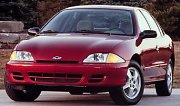What a shame that General Motors still rely on low-pricing as the sole winning formula. You know why GM’s cars could be so cheap, because they looks and smells cheap. Cavalier and Sunfire are with no exception, especially that they are assembled in Mexico. They made the Corolla looks as classy as Mercedes-Benz in terms of build and detailing while Honda’s four-cylinder feels as creamy as a V12. Their reliability record simply couldn’t match the Japanese cars. What they have are a quite-handsome-but-easily-get-tired styling, a roomy cabin and a big trunk. What they don’t have are quite a lot - the first one is a good engine. You may choose between a old pushrod 2.2-litre delivering 115-uninspiring horsepower or the famous twin-cam 2.4-litre Quad 4. In fact, it was famous of being the worst "modern" 4-valve engine in the world. Back in the late 80s, Quad 4 was GM’s first attempt to build a multi-valve engine rivaling the imports, but the 2.3-litre unit had so much vibration that quickly worsen GM’s already poor image, although it was good for 150 hp in standard form or 180 hp in sportier trim. Throughout the years, GM tried to cure the NVH problem by adding twin-balancer shafts, then increase 100 c.c. to boost torque, but it is still one of the harshest 4-valve engines today because the rest of the world kept improving during the past decade. No wonder the Quad-4 was dropped into this bargain duo. Obviously, GM has no intention to boost the Cavalier and Sunfire’s refinement to match the modern standards. The same could be found in the handling department. Admittedly, their front MacPherson strut plus rear torsion beam suspension layout are shared by some of the best European hatches, namely, Golf and Peugeot 306, but no matter the chassis or the tuning do not provide the necessary backing. Here is another rough and imprecise driving machine making the Civic feels exciting, let alone the Champion Ford Focus. Given the large engines, and an astonishing drag coefficient of 0.38 at least, America seems to be the only place where it could survive. However, you might not know, the Cavalier is selling in Japan as a Toyota due to the agreement between the two government years ago to reduce unbalanced trading. The coupe version
might be
better. First of all, they have a very emotional shape that looks like
a mini Firebird or Camaro. Secondly, when you buy a coupe, you won’t
expect
as much refinement as a saloon. That fits the Quad-4. Few cars in this
class have 150 hp and 155 lbft on tap. And no one could be as cheap as
the GM duo. If there is still life for ponycars, why not the mini
ponycars
? |
|||
| The above report was last updated on 1 Jan 2000. All Rights Reserved. |


